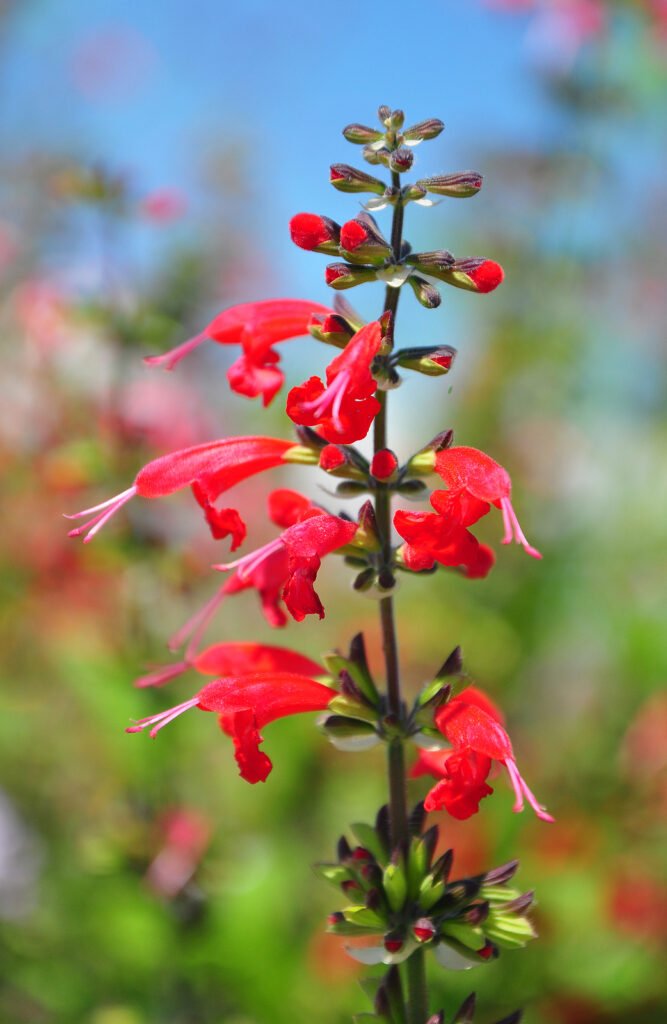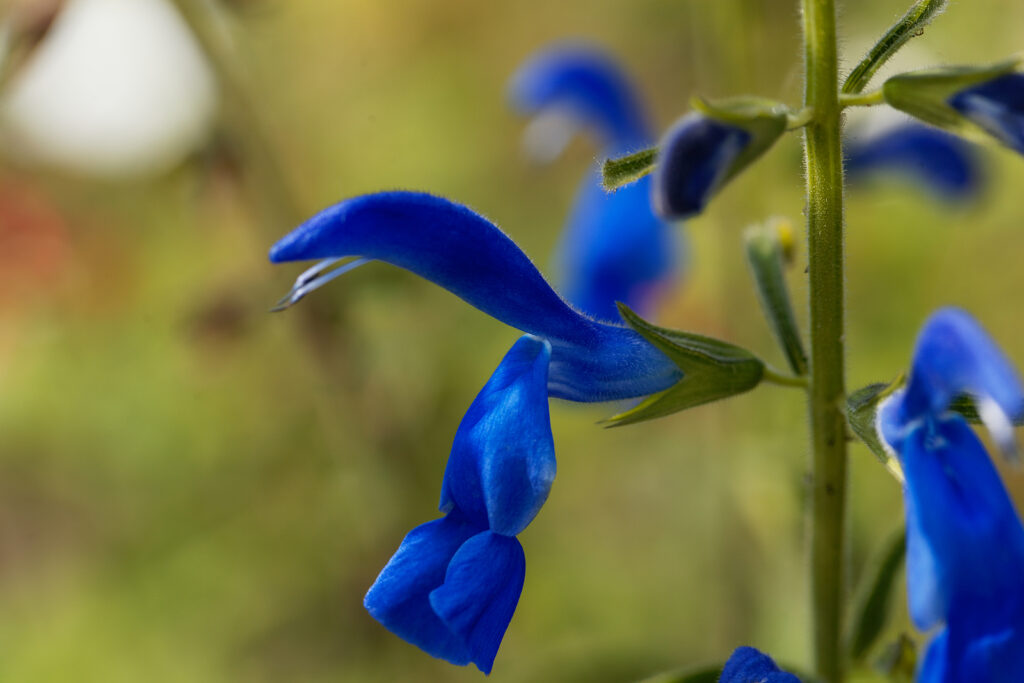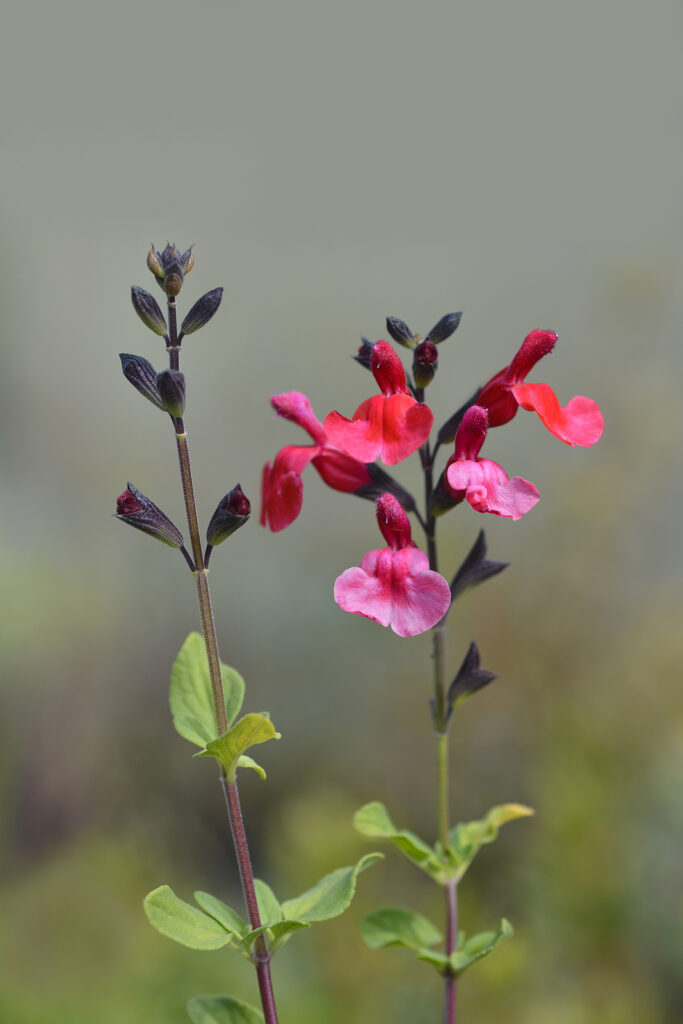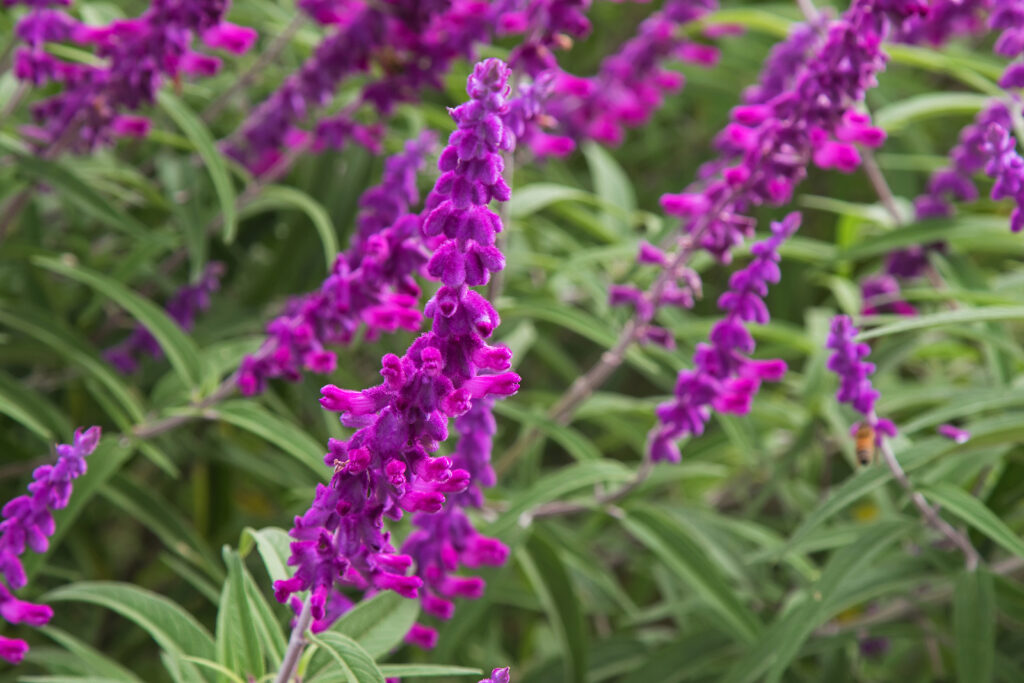Salvias are grown for their showy spikes of flowers. Flowers are 2-lipped–the upper lips erect and hooded, the lower ones are toothed and spreading. Flowers can be tubular to bell- or funnel-shaped in a wide range of colors.
Salvias make up a large genus of popular garden plants. There are many species of half-hardy annuals and biennials, as well as herbaceous and evergreen perennials.
Annual and perennial salvias can be added to bedding, borders, and containers. Salvias are great additions to sunny borders, woodland gardens, and wildflower meadows. In flower beds, salvias look best in large clumps.
Flower Garden Success Products at Amazon:
- Wildflower Seed Mix Attracts Hummingbirds and Butterflies
- Eden Brothers All Perennial Seed Mix
- 10 pcs Stainless Steel Garden Hand Tool Set
- Gorilla Cart 4 Cu. Ft, 300-pound Capacity
- Neem Bliss 100-% Cold Pressed Neem Oil
- Safer Brand Insect Killing Soap

Perennial Salvias Overview
Perennial salvias are a diverse group of flowering plants within the Salvia genus, known for their vibrant, long-lasting blooms and aromatic foliage. They come in various colors, including shades of blue, purple, pink, and white, and are highly valued for their low-maintenance nature and pollinator appeal. Native to various parts of the world, perennial salvias are often drought-tolerant and suitable for different garden styles, from cottage to formal borders.
Popular Perennial Salvia Varieties
Salvia nemorosa (Wood Sage/Meadow Sage)
- Description: One of the most commonly grown perennial salvias, Salvia nemorosa features dense spikes of small flowers and has a compact growth habit. Flower colors range from deep purple to blue and pink.
- Growth: Grows about 12-24 inches tall.
- Bloom Time: Late spring to early summer, with possible repeat blooming if deadheaded.
- Uses: Ideal for borders, mixed perennial beds, and cottage gardens. Its striking flower spikes create vertical interest, and the plant pairs well with other perennials such as coneflowers, catmint, and yarrow.
- Popular Cultivars: ‘May Night’ (deep blue), ‘Caradonna’ (violet with dark stems), ‘East Friesland’ (rich purple).
Salvia x sylvestris
- Description: A hybrid species similar to Salvia nemorosa, it is known for its upright habit and showy flower spikes.
- Growth: Reaches about 18-36 inches tall.
- Bloom Time: Early to mid-summer.
- Uses: Works well in sunny borders and as part of pollinator-friendly gardens. It’s an excellent plant for adding height and color contrast.
- Popular Cultivars: ‘Mainacht’ (synonymous with ‘May Night’), ‘Blue Hill’ (light blue).
Salvia greggii (Autumn Sage)
- Description: Native to Texas and Mexico, Salvia greggii is a heat-tolerant perennial with a bushy, woody base. The flowers are tubular and come in shades of red, pink, purple, and white.
- Growth: 12-36 inches tall and wide.
- Bloom Time: Late spring to fall, making it one of the longest-blooming salvias.
- Uses: Ideal for xeriscaping, rock gardens, and Mediterranean-style gardens. It can be used as a border plant or planted en masse for a colorful display.
- Popular Cultivars: ‘Hot Lips’ (red and white bicolor), ‘Furman’s Red’ (deep red), ‘Pink Preference’ (soft pink).
Salvia pratensis (Meadow Sage)
- Description: A European native with tall, upright spikes of flowers in shades of blue and purple. The foliage is typically broad and hairy.
- Growth: 18-30 inches tall.
- Bloom Time: Late spring to summer.
- Uses: Often planted in naturalistic or prairie-style gardens. The tall flower spikes add movement and vertical structure.
- Popular Cultivars: ‘Indigo’ (deep blue), ‘Rose Rhapsody’ (pink).
Salvia officinalis (Common Sage)
- Description: While primarily grown for its culinary uses, common sage also produces attractive purple or blue flowers. The plant has soft, gray-green leaves that are highly aromatic.
- Growth: 12-24 inches tall.
- Bloom Time: Late spring to early summer.
- Uses: Commonly used in herb gardens, but also suits mixed perennial borders where its foliage can add texture and interest even when not in bloom.
Salvia guaranitica (Anise-Scented Sage):
- Description: Known for its tall, arching stems and deep blue flowers, Salvia guaranitica adds dramatic flair to the garden. It has an anise-like fragrance.
- Growth: 3-5 feet tall.
- Bloom Time: Summer to fall.
- Uses: Works well as a background plant or in larger garden beds to create a focal point. It’s a favorite for attracting hummingbirds and works well with ornamental grasses and sun-loving perennials.
- Popular Cultivars: ‘Black and Blue’ (deep blue with black calyx), ‘Amistad’ (dark purple flowers).
Salvia sclarea (Clary Sage)
- Description: A biennial or short-lived perennial known for its large, colorful bracts and aromatic leaves. The flower bracts come in shades of white, pink, and purple.
- Growth: 2-4 feet tall.
- Bloom Time: Late spring to mid-summer.
- Uses: Clary sage is often used in cottage gardens and herbaceous borders. It pairs beautifully with roses, lavender, and other old-fashioned garden plants.
How to Use Perennial Salvias in the Garden
- Borders and Edging: Use lower-growing varieties like Salvia nemorosa to create striking borders that define garden beds or pathways.
- Pollinator Gardens: Salvias are a magnet for bees, butterflies, and hummingbirds, making them a staple in pollinator gardens. Plant in clusters for maximum visual impact and to attract more pollinators.
- Mixed Perennial Beds: Combine salvias with other perennials such as black-eyed Susans, coreopsis, and lavender for a colorful, textured garden.
- Drought-Tolerant Landscapes: Many perennial salvias, especially Salvia greggii and Salvia officinalis, thrive in dry conditions and are ideal for water-wise gardening.
- Cut Flower Gardens: The tall flower spikes of perennial salvias make excellent additions to cut flower arrangements.
- Cottage and Informal Gardens: Their natural, free-flowing growth makes them perfect for relaxed, informal garden settings.
Perennial Salvia Essential Garden Care Tips
- Sunlight: Salvias prefer full sun, although some varieties like Salvia pratensis can tolerate light shade.
- Soil: Well-draining soil is essential to prevent root rot. Salvias are generally not picky about soil type but benefit from organic matter.
- Watering: Once established, many salvias are drought-tolerant. Water deeply but infrequently.
- Maintenance: Deadhead spent flowers to promote reblooming. Prune in late fall or early spring to encourage bushier growth.
Perennial salvias are reliable, long-blooming, and versatile plants that can enhance any garden with their vivid colors and pollinator-friendly nature.
Get to know Salvia–sage
- Plant type: Annual, biennial, perennial depending on species (see list below)
- Growing zones and range: All zones as an annual and biennial; Zone 5-9 as hardy perennials; tender perennials can be grown as annuals.
- Hardiness: Varies depending on species (see varieties below)
- Height and width: 12 to 36 inches (30-91cm) depending on the species
- Foliage: Simple to pinnate, entire, toothed, notched, or scalloped leaves
- Flowers: Tubular 2-lipped flowers in rings on long showy spires
- Flower colors: Red, pink, purple, or white flushed with green, blue, or violet
- Bloom time: Summer in most regions; year-round in frost-free regions
- Uses: Beds, borders, cottage gardens
- Common name: Sage
- Botanical name: Salvia spp.
- Family: Lamiaceae
- Origin: Temperate and tropical regions worldwide
Where to plant Salvia–sage
- Plant salvias in full sun in most regions; plant in partial shade in regions where summer temperatures are consistently 90°F (32°C).
- Plant salvias in average to humus-rich garden soil.
- Salvia prefers a soil pH of 6 to 7.5.
Salvia uses and companions
- Plant Salvias in beds and borders and containers.
- Salvias are effective in a sunny border, light woodland, or wildflower meadow.
- Many Salvia species attract bees.
- Good garden companions for Salvia include Achillea, Coreopsis, Gazania, Gerbera jamesonii, Heuchera, Potentilla, Rudbeckia.

When to plant Salvia–sage
- Set salvias outdoors after all danger of frost has passed in spring.
- Start seed indoors 8 weeks before the last frost in spring
- Sow seed outdoors after all danger of frost has passed.
- Set indoor-grown plants outdoors in their permanent places after the last frost when the weather has settled.

Planting and spacing Salvia–sage
- Start seed indoors in flat or six-packs; cover seeds with 1/8 inch of soil.
- Water and keep seed warm 65° to 75°F (18°-24°C); seeds germinate in about 14 days, sometimes less. Grow in bright sunlight or a few inches below fluorescent light.
- Sow seed outdoors in drills about 2 inches (5cm) deep; plant seeds 2 inches (5cm) and cover with 1/8 inches of soil.
- Thin or transplant seedlings when they are about 4 inches (10cm) tall.
- Space salvias in the garden 8 to 36 inches (20-91cm) apart depending on the variety.

How to water and feed Salvia–sage
- Water young plants frequently; established plants should be watered just enough to keep the soil slightly moist, not wet.
- Fertilize salvias every 6 to 8 weeks with slow-release fertilizer, following the label directions.
Salvia–sage care
- Mulch plants in dry areas with 2 to 3 inches (5-7.6cm) of aged compost or chopped leaves.
- Pinch back seedlings for bushiness.
- Stake tall plants as needed, especially if growing in a windy area.
- Pests include cutworms and slugs; use collars to exclude these pests or dust ground with diatomaceous earth.

Salvia—sage propagation
- Grow annual salvias from seed; grow perennials from seed or by division.
- Seeds germinate in 12 to 15 days at 70°F (21°C); soak seeds of Salvia splendens to speed germination.
- Sow seeds indoors 4 to 6 weeks before the last frost for early blooms.
- All salvias can be grown from stem cuttings. Take stem cuttings during warm weather. Root under high humidity in a damp potting medium.
Good Products for Seed Starting Success at Amazon:
- Jump Start Germination Station w/Heat Mat Tray, 72-Cell Pack, Dome
- Espoma Seed Starting Mix
- 200 Count- Jiffy 7 Peat Soil Seed Starting Plugs
- Seed Starter Kit with Humidity Dome (120 Cells Total Tray)
- AgrobriteT5 Fluorescent, 2-Foot, Grow Light System

Salvia–sage varieties to grow
- Salvia argentea, silver sage. Biennial or short-lived perennial; small pinkish flowers; rosette of leaves covered with tiny silver hairs.
- S. azurea, blue sage. 3-foot (.9m) perennial, long blue or white flowers; upright open plant to 5 feet tall. Hardy to -20°F (-29°C).
- S. coccinea, scarlet sage, also called Texas sage. Half-hardy annual; spires of tubular red flowers grow to 3 feet (.9m) tall.
- S. columbariae. Half-hardy annual; spires of blue flowers within purple bracts; grows 1 to 2 feet (30-61cm) tall.
- S. elegans, pineapple sage, shrubby perennial to 6 feet (1.8m) tall, pineapple-scented leaves, and loose scarlet flowers.
- S. farinacea, Mealycup sage. Tender perennial is often grown as an annual; spires of blue or silvers blooms; calyx holding each 1/2 inch blossom is covered with short whitish hairs, giving the plant a mealy appearance; ‘Victoria’ series are cultivars with dense, intensely violet-blue flowers; it flowers over a long period. Hardy to 10°F (-12°C).
- S. farinacea cultivars. Cultivars of mealycup sage, silvery-white, shades of light blue, and dark blue.
- S. forskahlii. Perennial; flowers are long blue spires with white throats; plants grow to 3 feet (.9m) tall.
- S. greggii, autumn sage, 2-foot perennial (61cm), 3/4-inch long flowers in shades of red, purple, violet, pink, or yellow.
- S. guaranitica, bears deep blue 2-inch (5cm) long flowers with purple-blue calyxes.
- S. leucantha, Mexican sage, 3-foot (.9m) shrub with gray-green leaves and dense spikes of white or purple flowers tubular flowers.
- S. officinalis, garden sage, aromatic leaves used in cooking, racemes of lavender-blue flowers.
- S. patens, Gentian sage. Bright blue tubular long-blooming flowers in spikes; grows 12 to 42 inches (30-106cm) tall; arrow-shaped leaves 2 to 5 inches long covered with short, sticky hairs; evergreen in mild climates, grown as an annual in cold winter regions.
- S. pratensis, meadow clary. Perennial, sprays of lavender-blue claw-shaped flowers; grows to 3 feet (.9m) tall. Hardy to -20°F (-29°C).
- S. splendens, Scarlet sage. Annual; bright blue blooms; colors also include white, pink, violet, and deep purple. Cultivars include ‘Carabiniere’ with scarlet flowers, ‘Fireworks’ with red and white striped flowers. ‘Pirate’ with brilliant red flowers, ‘Purple Blaze’ with deep purple flowers, ‘Red Hot Sally’ has deep red blooms.
- S. x superba (nemerosa), violet sage. Perennials with violet-blue or purple flowers; grow to 36 inches (91cm) tall; cultivars include ‘East Friesland’ which is purple and ‘Mainacht’ which is deep violet-blue. Hardy to -20°F (-29°C).
- S. x sylvesris, hybrid sage, bears racemes of pinkish-purple flowers; cultivar ‘East Friesland’ bears violet-blue flowers; other cultivars are ‘May Night’ and ‘Mainacht’ and ‘Rose Queen’,
- S. viridis, clary sage. Tender annual with bracts of white, violet, or rose blooms; grow to 18 inches (45cm) tall.



